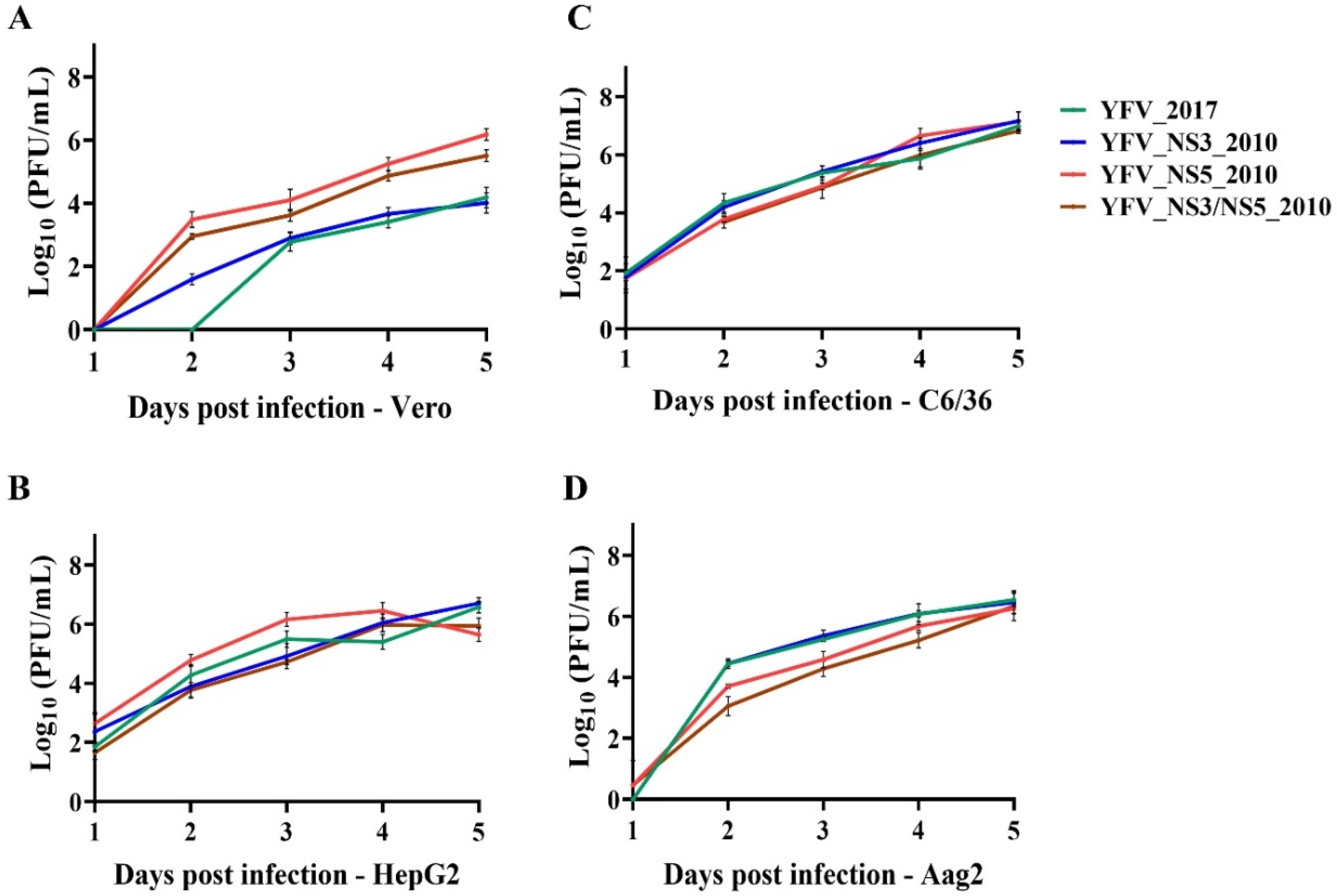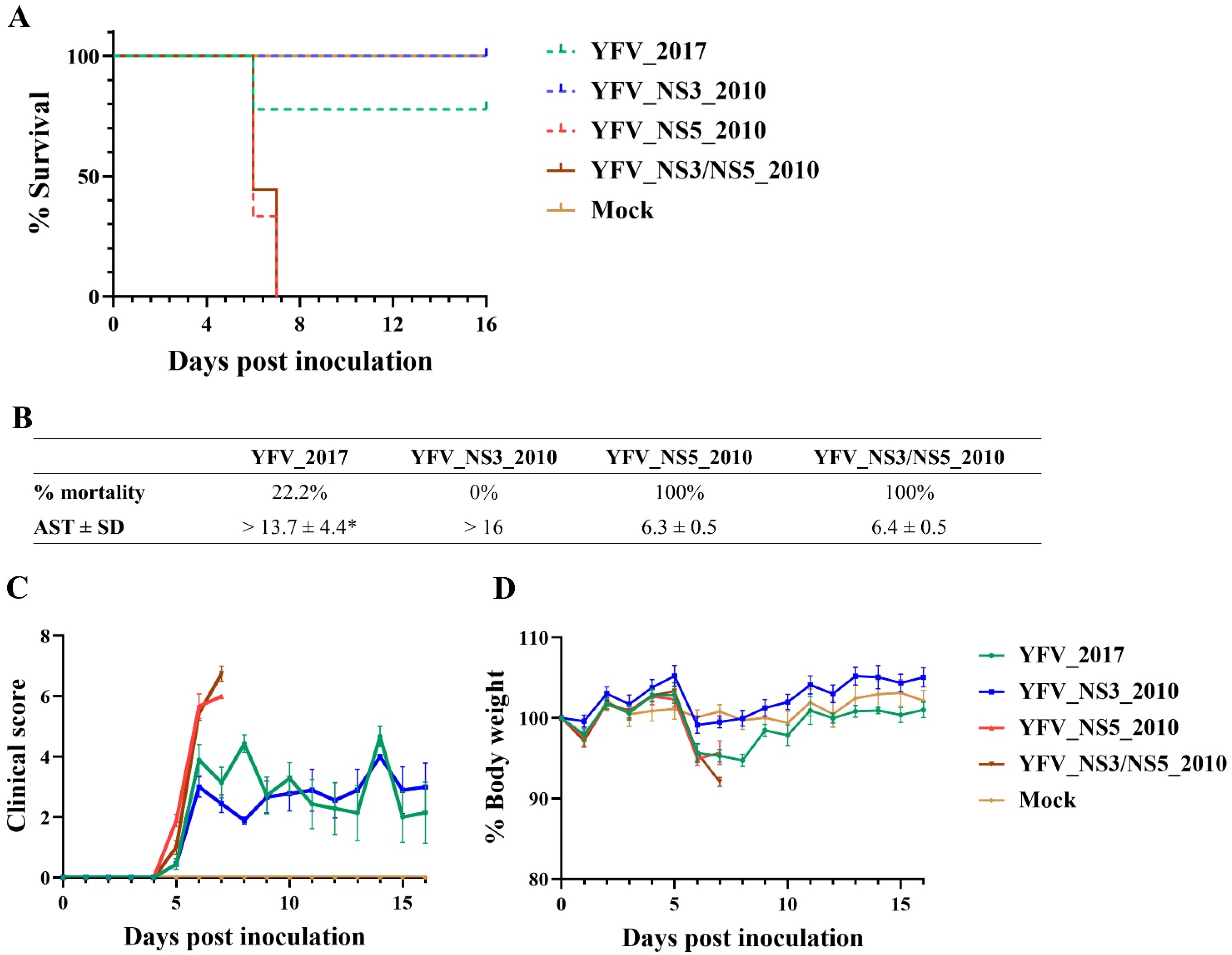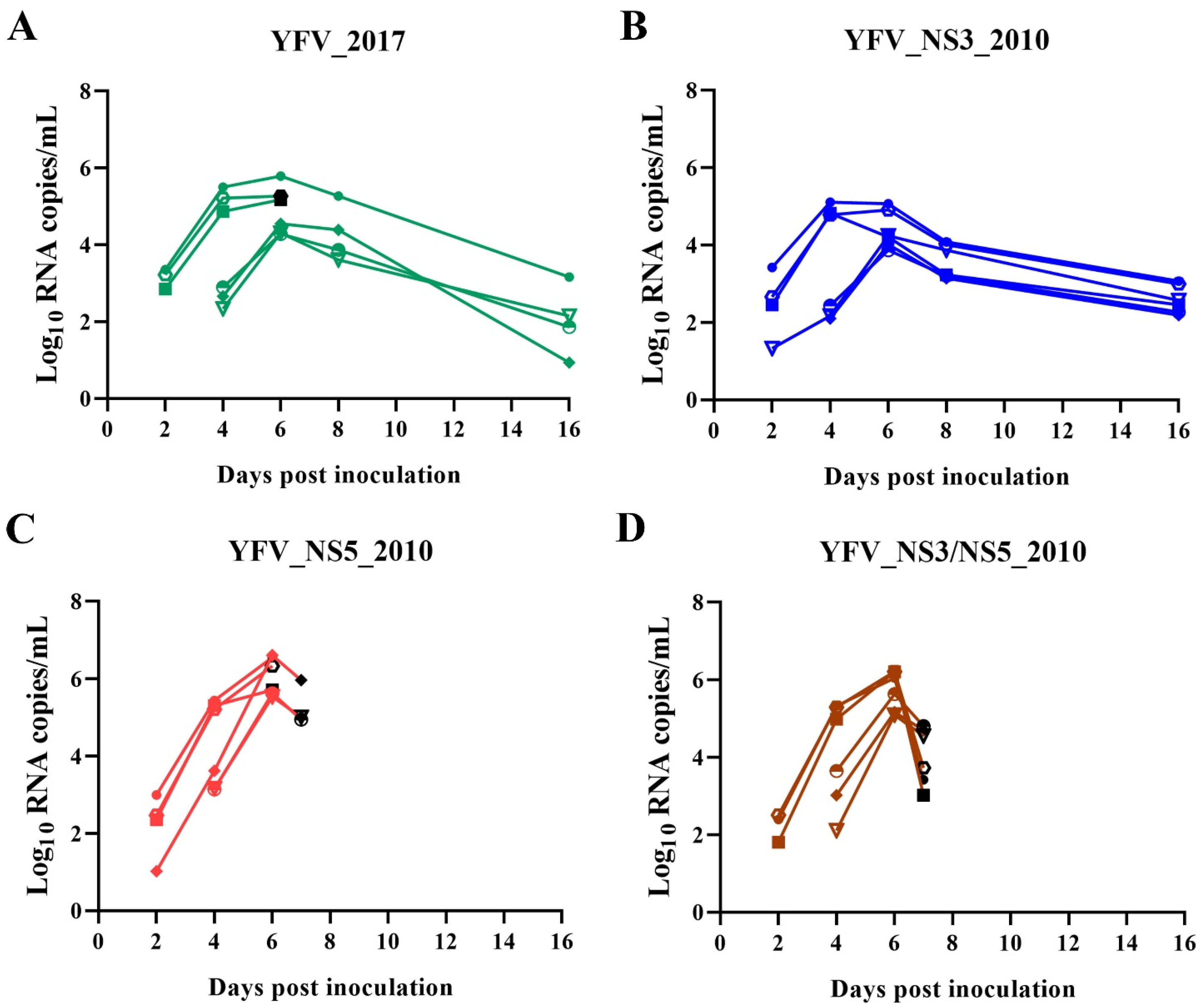Phenotypic and Genetic Studies of the Viral Lineage Associated with the Recent Yellow Fever Outbreak in Brazil
Abstract
:1. Introduction
2. Materials and Methods
2.1. Synthesis of the YFV Infectious Clone
2.2. Insertion of Genetic Markers
2.3. Viral Stocks
2.4. Plaque Phenotype Assay
2.5. Viral Growth Kinetics in Different Cell Lines
2.6. Viral Infection in the Presence of Type I Interferon
2.7. Animal Experimentation
2.7.1. BALB/c Mice
2.7.2. AG129 Mice
3. Results
3.1. Influence of the YFV 2016–2019 Molecular Signature on Infectivity in Cell Cultures
3.2. Interference of the Molecular Signature on the Innate Immune Response Mediated by Type I Interferon
3.3. Effects of the Molecular Signature Polymorphisms upon Mouse Inoculation
3.3.1. BALB/c Mice
3.3.2. AG129 Mice
4. Discussion
Supplementary Materials
Author Contributions
Funding
Institutional Review Board Statement
Data Availability Statement
Acknowledgments
Conflicts of Interest
References
- Douam, F.; Ploss, A. Yellow Fever Virus: Knowledge Gaps Impeding the Fight Against an Old Foe. Trends Microbiol. 2018, 26, 913–928. [Google Scholar] [CrossRef] [PubMed]
- Franco, O. Campanhas de Osvaldo Cruz. In História da Febre-Amarela no Brasil; Ministério da Saúde—Departamento Nacional de Endemias Rurais: Rio de Janeiro, Brasil, 1969; pp. 75–94. [Google Scholar]
- De la Santé, O.M.; World Health Organization. Yellow Fever in Africa and the Americas, 2018—Fièvre jaune en Afrique et dans les Amériques, 2018. Wkly Epidemiol. Rec. 2019, 94, 365–378. [Google Scholar]
- De Oliveira Figueiredo, P.; Stoffella-Dutra, A.G.; Barbosa Costa, G.; Silva de Oliveira, J.; Dourado Amaral, C.; Duarte Santos, J.; Soares Rocha, K.L.; Araujo Junior, J.P.; Lacerda Nogueira, M.; Zaza Borges, M.A.; et al. Re-Emergence of Yellow Fever in Brazil during 2016–2019: Challenges, Lessons Learned, and Perspectives. Viruses 2020, 12, 1233. [Google Scholar] [CrossRef] [PubMed]
- BRASIL. Health Brazil 2019: A health situation analysis focusing on immunopreventable diseases and immunization. Brasília; Ministério da Saúde; 2019, 305–330. Governmental Document. Available online: http://bvsms.saude.gov.br/bvs/publicacoes/saude_brasil_2020-2021_analise_pandemia_covid-19.pdf (accessed on 22 December 2021).
- BRASIL. Boletim Epidemiológico 46. 2020, 51. Governmental Document. Available online: https://www.gov.br/saude/pt-br/media/pdf/2020/dezembro/09/boletim_epidemiologico_svs_46.pdf (accessed on 22 December 2021).
- BRASIL. Boletim Epidemiológico 31. 2021, 52, 20–30. Governmental Document. Available online: https://www.gov.br/saude/pt-br/centrais-de-conteudo/publicacoes/boletins/boletins-epidemiologicos/2021/boletim_epidemiologico_svs_31.pdf (accessed on 22 December 2021).
- Possas, C.; Lourenco-de-Oliveira, R.; Tauil, P.L.; Pinheiro, F.P.; Pissinatti, A.; Cunha, R.V.D.; Freire, M.; Martins, R.M.; Homma, A. Yellow fever outbreak in Brazil: The puzzle of rapid viral spread and challenges for immunisation. Mem. Inst. Oswaldo Cruz 2018, 113, e180278. [Google Scholar] [CrossRef] [PubMed]
- Maljkovic Berry, I.; Eyase, F.; Pollett, S.; Konongoi, S.L.; Joyce, M.G.; Figueroa, K.; Ofula, V.; Koka, H.; Koskei, E.; Nyunja, A.; et al. Global Outbreaks and Origins of a Chikungunya Virus Variant Carrying Mutations Which May Increase Fitness for Aedes aegypti: Revelations from the 2016 Mandera, Kenya Outbreak. Am. J. Trop. Med. Hyg. 2019, 100, 1249–1257. [Google Scholar] [CrossRef]
- Tsetsarkin, K.A.; Vanlandingham, D.L.; McGee, C.E.; Higgs, S. A single mutation in chikungunya virus affects vector specificity and epidemic potential. PLoS Pathog. 2007, 3, e201. [Google Scholar] [CrossRef]
- Ebel, G.D.; Carricaburu, J.; Young, D.; Bernard, K.A.; Kramer, L.D. Genetic and phenotypic variation of West Nile virus in New York, 2000–2003. Am. J. Trop. Med. Hyg. 2004, 71, 493–500. [Google Scholar] [CrossRef]
- Snapinn, K.W.; Holmes, E.C.; Young, D.S.; Bernard, K.A.; Kramer, L.D.; Ebel, G.D. Declining growth rate of West Nile virus in North America. J. Virol. 2007, 81, 2531–2534. [Google Scholar] [CrossRef] [PubMed]
- Moudy, R.M.; Zhang, B.; Shi, P.Y.; Kramer, L.D. West Nile virus envelope protein glycosylation is required for efficient viral transmission by Culex vectors. Virology 2009, 387, 222–228. [Google Scholar] [CrossRef] [PubMed]
- Bonaldo, M.C.; Gomez, M.M.; Dos Santos, A.A.; Abreu, F.V.S.; Ferreira-de-Brito, A.; Miranda, R.M.; Castro, M.G.; Lourenco-de-Oliveira, R. Genome analysis of yellow fever virus of the ongoing outbreak in Brazil reveals polymorphisms. Mem. Inst. Oswaldo Cruz 2017, 112, 447–451. [Google Scholar] [CrossRef] [PubMed]
- Gomez, M.M.; Abreu, F.V.S.; Santos, A.; Mello, I.S.; Santos, M.P.; Ribeiro, I.P.; Ferreira-de-Brito, A.; Miranda, R.M.; Castro, M.G.; Ribeiro, M.S.; et al. Genomic and structural features of the yellow fever virus from the 2016–2017 Brazilian outbreak. J. Gen. Virol. 2018, 99, 536–548. [Google Scholar] [CrossRef] [PubMed]
- Noske, G.D.; Gawriljuk, V.O.; Fernandes, R.S.; Furtado, N.D.; Bonaldo, M.C.; Oliva, G.; Godoy, A.S. Structural characterization and polymorphism analysis of the NS2B-NS3 protease from the 2017 Brazilian circulating strain of Yellow Fever virus. Biochim. Biophy.s Acta Gen. Subj. 2020, 1864, 129521. [Google Scholar] [CrossRef] [PubMed]
- Furtado, N.D.; Raphael, L.M.; Ribeiro, I.P.; de Mello, I.S.; Fernandes, D.R.; Gomez, M.M.; Dos Santos, A.A.C.; Nogueira, M.D.S.; de Castro, M.G.; de Abreu, F.V.S.; et al. Biological Characterization of Yellow Fever Viruses Isolated from Non-Human Primates in Brazil with Distinct Genomic Landscapes. Front. Microbiol. 2022, 13, 757084. [Google Scholar] [CrossRef] [PubMed]
- De Mello, I.S.; Fernandes, D.R.; Furtado, N.D.; Dos Santos, A.A.C.; Dos Santos, M.P.; Ribeiro, I.P.; Raphael, L.M.S.; Nogueira, M.D.S.; da Cruz, S.O.D.; Rocha, A.D.S.; et al. Recovery of Synthetic Zika Virus Based on Rio-U1 Isolate Using a Genetically Stable Two Plasmid System and cDNA Amplification. Front. Microbiol. 2021, 12, 639655. [Google Scholar] [CrossRef] [PubMed]
- Auguste, A.J.; Lemey, P.; Bergren, N.A.; Giambalvo, D.; Moncada, M.; Moron, D.; Hernandez, R.; Navarro, J.C.; Weaver, S.C. Enzootic transmission of yellow fever virus, Venezuela. Emerg. Infect. Dis. 2015, 21, 99–102. [Google Scholar] [CrossRef] [PubMed]
- Abreu, F.V.S.; Ribeiro, I.P.; Ferreira-de-Brito, A.; Santos, A.; Miranda, R.M.; Bonelly, I.S.; Neves, M.; Bersot, M.I.; Santos, T.P.D.; Gomes, M.Q.; et al. Haemagogus leucocelaenus and Haemagogus janthinomys are the primary vectors in the major yellow fever outbreak in Brazil, 2016–2018. Emerg. Microbes Infect. 2019, 8, 218–231. [Google Scholar] [CrossRef]
- Bonaldo, M.C.; Garratt, R.C.; Caufour, P.S.; Freire, M.S.; Rodrigues, M.M.; Nussenzweig, R.S.; Galler, R. Surface expression of an immunodominant malaria protein B cell epitope by yellow fever virus. J. Mol. Biol. 2002, 315, 873–885. [Google Scholar] [CrossRef]
- Barrett, A.D.; Gould, E.A. Comparison of neurovirulence of different strains of yellow fever virus in mice. J. Gen. Virol. 1986, 67 Pt 4, 631–637. [Google Scholar] [CrossRef]
- Aliota, M.T.; Caine, E.A.; Walker, E.C.; Larkin, K.E.; Camacho, E.; Osorio, J.E. Characterization of Lethal Zika Virus Infection in AG129 Mice. PLoS Negl. Trop. Dis. 2016, 10, e0004682. [Google Scholar] [CrossRef] [PubMed]
- Abreu, F.V.S.; Delatorre, E.; Dos Santos, A.A.C.; Ferreira-de-Brito, A.; de Castro, M.G.; Ribeiro, I.P.; Furtado, N.D.; Vargas, W.P.; Ribeiro, M.S.; Meneguete, P.; et al. Combination of surveillance tools reveals that Yellow Fever virus can remain in the same Atlantic Forest area at least for three transmission seasons. Mem. Inst. Oswaldo Cruz 2019, 114, e190076. [Google Scholar] [CrossRef]
- Delatorre, E.; de Abreu, F.V.S.; Ribeiro, I.P.; Gomez, M.M.; Dos Santos, A.A.C.; Ferreira-de-Brito, A.; Neves, M.; Bonelly, I.; de Miranda, R.M.; Furtado, N.D.; et al. Distinct YFV Lineages Co-Circulated in the Central-Western and Southeastern Brazilian Regions from 2015 to 2018. Front. Microbiol. 2019, 10, 1079. [Google Scholar] [CrossRef]
- Fitzgeorge, R.; Bradish, C.J. The in vivo differentiation of strains of yellow fever virus in mice. J. Gen. Virol. 1980, 46, 1–13. [Google Scholar] [CrossRef] [PubMed]
- Fuchs, J.; Chu, H.; O’Day, P.; Pyles, R.; Bourne, N.; Das, S.C.; Milligan, G.N.; Barrett, A.D.; Partidos, C.D.; Osorio, J.E. Investigating the efficacy of monovalent and tetravalent dengue vaccine formulations against DENV-4 challenge in AG129 mice. Vaccine 2014, 32, 6537–6543. [Google Scholar] [CrossRef] [PubMed]
- Partidos, C.D.; Weger, J.; Brewoo, J.; Seymour, R.; Borland, E.M.; Ledermann, J.P.; Powers, A.M.; Weaver, S.C.; Stinchcomb, D.T.; Osorio, J.E. Probing the attenuation and protective efficacy of a candidate chikungunya virus vaccine in mice with compromised interferon (IFN) signaling. Vaccine 2011, 29, 3067–3073. [Google Scholar] [CrossRef]
- Sumathy, K.; Kulkarni, B.; Gondu, R.K.; Ponnuru, S.K.; Bonguram, N.; Eligeti, R.; Gadiyaram, S.; Praturi, U.; Chougule, B.; Karunakaran, L.; et al. Protective efficacy of Zika vaccine in AG129 mouse model. Sci. Rep. 2017, 7, 46375. [Google Scholar] [CrossRef] [PubMed]
- Meier, K.C.; Gardner, C.L.; Khoretonenko, M.V.; Klimstra, W.B.; Ryman, K.D. A mouse model for studying viscerotropic disease caused by yellow fever virus infection. PLoS Pathog. 2009, 5, e1000614. [Google Scholar] [CrossRef]
- Thibodeaux, B.A.; Garbino, N.C.; Liss, N.M.; Piper, J.; Blair, C.D.; Roehrig, J.T. A small animal peripheral challenge model of yellow fever using interferon-receptor deficient mice and the 17D-204 vaccine strain. Vaccine 2012, 30, 3180–3187. [Google Scholar] [CrossRef]
- Zompi, S.; Santich, B.H.; Beatty, P.R.; Harris, E. Protection from secondary dengue virus infection in a mouse model reveals the role of serotype cross-reactive B and T cells. J. Immunol. 2012, 188, 404–416. [Google Scholar] [CrossRef] [PubMed]
- Laurent-Rolle, M.; Morrison, J.; Rajsbaum, R.; Macleod, J.M.L.; Pisanelli, G.; Pham, A.; Ayllon, J.; Miorin, L.; Martinez, C.; tenOever, B.R.; et al. The interferon signaling antagonist function of yellow fever virus NS5 protein is activated by type I interferon. Cell Host Microbe 2014, 16, 314–327. [Google Scholar] [CrossRef]
- Miorin, L.; Laurent-Rolle, M.; Pisanelli, G.; Co, P.H.; Albrecht, R.A.; Garcia-Sastre, A.; Morrison, J. Host-Specific NS5 Ubiquitination Determines Yellow Fever Virus Tropism. J. Virol. 2019, 93, e00151-19. [Google Scholar] [CrossRef] [PubMed]
- Kleinert, R.D.V.; Montoya-Diaz, E.; Khera, T.; Welsch, K.; Tegtmeyer, B.; Hoehl, S.; Ciesek, S.; Brown, R.J.P. Yellow Fever: Integrating Current Knowledge with Technological Innovations to Identify Strategies for Controlling a Re-Emerging Virus. Viruses 2019, 11, 960. [Google Scholar] [CrossRef] [PubMed]
- Li, Y.; Yang, Z. Adaptive Diversification between Yellow Fever Virus West African and South American Lineages: A Genome-Wide Study. Am. J. Trop. Med. Hyg. 2017, 96, 727–734. [Google Scholar] [CrossRef] [PubMed]






| Synthetic YFV | NS3 | NS5 | ||||||
|---|---|---|---|---|---|---|---|---|
| Protease | MTase | RdRp | ||||||
| 88 | 121 | 101 | 138 | 173 | 297 | 643 | 709 | |
| YFV_2017 | D | K | R | I | S | S | A | S |
| YFV_NS3_2010 | E | R | R | I | S | S | A | S |
| YFV_NS5_2010 | D | K | K | V | G | N | V | N |
| YFV_NS3/NS5_2010 | E | R | K | V | G | N | V | N |
Publisher’s Note: MDPI stays neutral with regard to jurisdictional claims in published maps and institutional affiliations. |
© 2022 by the authors. Licensee MDPI, Basel, Switzerland. This article is an open access article distributed under the terms and conditions of the Creative Commons Attribution (CC BY) license (https://creativecommons.org/licenses/by/4.0/).
Share and Cite
Furtado, N.D.; Gómez, M.M.; de Mello, I.S.; Fernandes, D.R.; Bonaldo, M.C. Phenotypic and Genetic Studies of the Viral Lineage Associated with the Recent Yellow Fever Outbreak in Brazil. Viruses 2022, 14, 1818. https://doi.org/10.3390/v14081818
Furtado ND, Gómez MM, de Mello IS, Fernandes DR, Bonaldo MC. Phenotypic and Genetic Studies of the Viral Lineage Associated with the Recent Yellow Fever Outbreak in Brazil. Viruses. 2022; 14(8):1818. https://doi.org/10.3390/v14081818
Chicago/Turabian StyleFurtado, Nathália Dias, Mariela Martínez Gómez, Iasmim Silva de Mello, Déberli Ruiz Fernandes, and Myrna Cristina Bonaldo. 2022. "Phenotypic and Genetic Studies of the Viral Lineage Associated with the Recent Yellow Fever Outbreak in Brazil" Viruses 14, no. 8: 1818. https://doi.org/10.3390/v14081818
APA StyleFurtado, N. D., Gómez, M. M., de Mello, I. S., Fernandes, D. R., & Bonaldo, M. C. (2022). Phenotypic and Genetic Studies of the Viral Lineage Associated with the Recent Yellow Fever Outbreak in Brazil. Viruses, 14(8), 1818. https://doi.org/10.3390/v14081818






